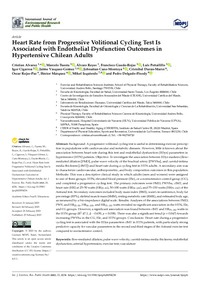Mostrar el registro sencillo de la publicación
Heart rate from progressive volitional cycling test is associated with endothelial dysfunction outcomes in hypertensive chilean adults
| dc.contributor.author | Alvarez, Cristian | |
| dc.contributor.author | Tuesta, Marcelo | |
| dc.contributor.author | Reyes, Álvaro | |
| dc.contributor.author | Guede Rojas, Francisco | |
| dc.contributor.author | Peñailillo, Luis | |
| dc.contributor.author | Cigarroa, Igor | |
| dc.contributor.author | Vásquez-Gómez, Jaime A. | |
| dc.contributor.author | Cano-Montoya, Johnattan | |
| dc.contributor.author | Durán-Marín, Cristóbal | |
| dc.contributor.author | Rojas-Paz, Oscar | |
| dc.contributor.author | Márquez, Héctor | |
| dc.contributor.author | Izquierdo, Mikel | |
| dc.contributor.author | Delgado-Floody, Pedro | |
| dc.date.accessioned | 2023-03-29T12:37:19Z | |
| dc.date.available | 2023-03-29T12:37:19Z | |
| dc.date.issued | 2023 | |
| dc.identifier.uri | http://repositorio.ucm.cl/handle/ucm/4598 | |
| dc.description.abstract | Background: A progressive volitional cycling test is useful in determining exercise prescription in populations with cardiovascular and metabolic diseases. However, little is known about the association between heart rate during this test and endothelial dysfunction (EDys) parameters in hypertensive (HTN) patients. Objective: To investigate the association between EDys markers (flowmediated dilation [FMD], pulse wave velocity of the brachial artery [PWVba], and carotid-intima media thickness [cIMT]) and heart rate during a cycling test in HTN adults. A secondary aim was to characterize cardiovascular, anthropometric, and body composition outcomes in this population. Methods: This was a descriptive clinical study in which adults (men and women) were assigned to one of three groups: HTN, elevated blood pressure (Ele), or a normotensive control group (CG), and completed a progressive cycling test. The primary outcomes were FMD, PWVba, cIMT, and heart rate (HR) at 25–50 watts (HR25–50), 50–100 watts (HR50–100), and 75–150 watts (HR75–150) of the Astrand test. Secondary outcomes included body mass index (BMI), waist circumference, body fat percentage (BF%), skeletal muscle mass (SMM), resting metabolic rate (RMR), and estimated body age, as measured by a bio-impedance digital scale. Results: Analyses of the associations between FMD, PWV, and HR25–50, HR50–100, and HR75–150 watts revealed no significant association in the HTN, Ele, and CG groups. However, a significant association was found between cIMT and HR75–150 watts in the HTN group (R2 47.1, β −0.650, p = 0.038). There was also a significant trend (p = 0.047) towards increasing PWVba in the CG, Ele, and HTN groups. Conclusion: Heart rate during a progressive cycling test is associated with the EDys parameters cIMT in HTN patients, with particularly strong predictive capacity for vascular parameters in the second and third stages of the Astrand exercise test compared to normotensive control. | es_CL |
| dc.language.iso | en | es_CL |
| dc.rights | Atribución-NoComercial-SinDerivadas 3.0 Chile | * |
| dc.rights.uri | http://creativecommons.org/licenses/by-nc-nd/3.0/cl/ | * |
| dc.source | International Journal of Environmental Research and Public Health, 20(5), 4236 | es_CL |
| dc.subject | Flow-mediated dilation | es_CL |
| dc.subject | Pulse wave velocity | es_CL |
| dc.subject | Carotid-intima media thickness | es_CL |
| dc.subject | Endothelial dysfunction | es_CL |
| dc.subject | Arterial hypertension | es_CL |
| dc.subject | Exercise test | es_CL |
| dc.subject | Vasculature | es_CL |
| dc.title | Heart rate from progressive volitional cycling test is associated with endothelial dysfunction outcomes in hypertensive chilean adults | es_CL |
| dc.type | Article | es_CL |
| dc.ucm.indexacion | Scopus | es_CL |
| dc.ucm.indexacion | Isi | es_CL |
| dc.ucm.uri | mdpi.com/1660-4601/20/5/4236 | es_CL |
| dc.ucm.doi | doi.org/10.3390/ijerph20054236 | es_CL |



